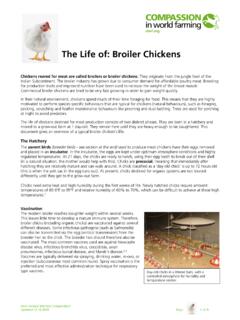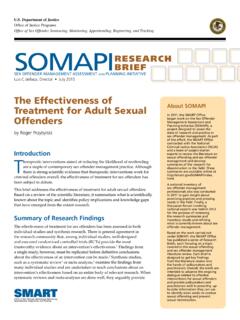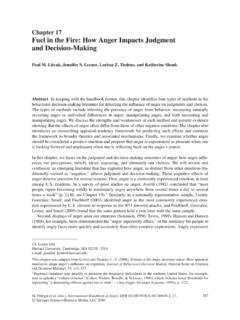Transcription of 04 Verbal Communication - SAGE Publications Inc
1 AFOCUS QUESTIONS1 How is Verbal Communication symbolic?2 How does Verbal Communication involve meaning ?3 How is Verbal Communication relational?4 How is Verbal Communication cultural?5 What frames your understanding of Verbal Communication ? 6 What is the presentational nature of Verbal Communication ?7 What are the functions of Verbal Communication ?man walked into a bar. A second man walked into a bar. A third one didn t .. because he ducked. You know the word bar, and you most likely know that in some cultures jokes and stories often start with the phrase A man walked into a bar. Such cultural knowledge frames expectations about the story being told. A frame, you recall from Chapter 1, is a context that influences the interpretation of Communication . However, the word bar has different meanings. If you were faintly amused by the opening sentences here, it is partly because the word is used in the first sentence differ-ently than you expected on the basis of the frame of the story.
2 The punch line works only because you are misled twice into thinking of a different kind of bar. Familiarity with the story s cultural form frames your expectations in a way that pulls the last sentence right out from under you. Language has a gram-matical structure, but when used conversationally, it uses cultural and relational Communication involves the use of language. Notice that the word use is emphasized in this definition. When discussing Verbal communica-tion, Communication scholars do not simply look at language but rather explore the ways in which it is used when interacting with others. Language is just a collection of symbols that can be arranged in a particular order according to a particular grammar. Remember, though, that symbols themselves have no meaning . Words, like all symbols, are given meaning when they are put into use. Within this chapter, we explore the ways in which language is put into chapter is structured somewhat differently than others within this book.
3 In exploring Verbal Communication , we will essentially be following the characteristics of Communication discussed in Chapter 1. Accordingly, we will talk about how Verbal Communication is symbolic, involves meaning , is rela-tional, is cultural, involves frames, is presentational, and is transactive. Doing so will reinforce those characteristics for when they are not explicitly addressed but still involved when discussing other types of Communication . The application of those characteristics when discussing Verbal Communication will also provide a clear understanding of Verbal Communication in everyday Is Verbal Communication Symbolic?The answer to the opening question is pretty obvious if you have already read the introductory paragraphs of this chapter. If you have not read them, why are you starting here? Go read them, and we will wait.. All right, the answer is: Verbal Communication involves the use of language, which is made up of Communication : the use of language04 Verbal Communication sage PublicationsCOMMUNICATION SKILLS PAR T II70 Symbols are arbitrary representations of something else, which means there is no direct connection between a symbol and what it represents.
4 When it comes to the word chair, used as an earlier example of symbols, there is no natural connection between an object on which you sit and the five letters r, h, c, a, and i arranged in the order c, h, a, i, r. That symbol is just used to represent that a result of the arbitrary nature of sym-bols, the meanings applied to words are some-what ambiguous. There is often some degree of agreement on the meanings that should be applied to words, but there is never complete agreement on the meaning associated with any word, even the most basic and common words. Consider the brother and sister who asked their parents if they could keep in the family s tiny apartment the stray dog they had found. Agreeing without actually seeing the dog, the parents expected to find a small dog only to find an extremely large Great Dane. The meaning the parents applied to the symbol dog did not fully correspond with the meaning the children intended when using that will talk more about meaning in the next section, but for now notice the use of applied in the last paragraph.
5 It is not that words have meanings but that meanings are applied to words. Symbols have no inherent meaning . They are given meaning along with value and power when they are used during interactions among people. This fact does not mean that studying language is mean-ingless many of our linguist friends would certainly take issue with that notion. However, as much as your authors enjoy learning new words and studying the development of languages, we find the actual use of words more interest-ing. It is through the actual use of language that meanings develop. Moreover, it is through the use of language, along with other symbolic activity, that relationships, identities, cultures, and realities are transacted. Now that is really fascinating! Verbal Communication Involves MeaningSo, we know that Verbal Communication is symbolic and that meanings are established through its use. And, later in this chapter, we explore how people go about assigning mean-ings using a Communication frame.
6 Before tackling that issue, though, we need to examine what meaning actually means. Words are given the following two types of meaning : Why might this pairing of street signs be amusing to a citizen in the United States, and what is taken for granted by those who understand the joke? By the Ta aOf the thousands of languages worldwide, the most complicated may be Taa, which is primarily spoken in Botswana. It has 112 distinct sounds, more than any other language. (For comparison, English has around 45 sounds, depending on the dialect.) Making Taa particularly complicated, the majority of the words start with one of 83 sorts of TO CONSIDER1. If you speak more than one language, what does that tell you about the arbitrary nature of symbols?2. If you only speak one language, do you think this makes the arbitrary nature of symbols more difficult to grasp? sage Publications71 CHAPTER 4 Verbal Communication denotative and connotative.
7 Taking things one step fur-ther, words are also given value based on the meanings and Connotative MeaningsWords, as with all symbols, can be given multiple mean-ings depending on how they are used and the circum-stances surrounding their use (Ogden & Richards, 1946). Polysemy is the term used to recognize that there can be multiple meanings given to the same word. If all symbols can have several different meanings, then each time you speak or hear a word, you must determine which mean-ing meaning is the general meaning of a word. It is the meaning or meanings appearing next to each word in the dictionary. (Dictionary and denotative both obviously start with the same letter, if you need help remember-ing the term on an examination.) If you point at a cat and say, Cat, everyone will know that the sound denotes the object that is furry and whiskered and currently sleeping on your keyboard as you read this the same object or idea by the same words is an obviously funda-mental requirement for communicating.
8 Conversation works only when people can assume that they share the world by using the same words to denote items. Remember, there is never complete agreement by indi-viduals on the meanings of any word, but there is often at least some overlap of mean-ings. The polysemic nature of words can make determining intended meaning a chal-lenging task, meaning refers to the overtones and implications associ-ated with a word or an object. For example, cats are seen as independent, cud-dly, hunters, companions, irritations, allergens, stalkers, stealthy, and incredibly lucky both in landing on their feet all the time and in having nine lives. If you talk about a friend as a pussycat, you are most likely referring to the connotative meaning and implying that he is soft and cuddly and perhaps stealthy, compan-ionable, and lucky. You are unlikely to be referring to the denotative meaning and warning people that he or she is actually, secretly a cat and has fur and sleeps on connoting involves the implications of a word, some words carry baggage that can elicit an emotional response.
9 Consider, for instance, the different emo-tions stirred up by the words patriot and traitor. The first connotes many good feelings of loyalty, duty, and faithfulness. The second connotes bad qualities like deceit, two-facedness, untrustworthiness, and disloyalty. These connotations are polysemy: the fact that multiple meanings can be associated with a given word or symbol rather than just one unambiguous meaningdenotative meaning : the identification of something by pointing it out ( that is a cat )Sapir-Whorf hypothesis: the idea that it is the names of objects and ideas that make Verbal distinctions and help you make conceptual distinctions rather than the other way aroundconnotative meaning : the overtones, implications, or additional meanings associated with a word or an objectLanguage and PerceptionDeveloped from the writings of Edward Sapir and Benjamin Whorf (Sapir, 1949; Whorf, 1956), the Sapir-Whorf hypothesis proposes that you think what you can say.
10 In other words, the names that make Verbal distinctions also help you make conceptual distinctions rather than the other way around. Essentially, the language you speak impacts how you view the world. Other scholars oppose this notion of linguistic relativism and might ask the first question as TO CONSIDER1. English speakers have a word for the front of the hand (palm), but no single word for the back. According to the Sapir-Whorf hypothesis, does this mean that English speakers should not be able to tell the difference?2. To what extent do you believe language shapes how people view the world? DISCIPLINARY DEBATEWhat factors might be influencing the conversation of these two people? sage PublicationsCOMMUNICATION SKILLS PAR T II72extra layers of meaning atop the denotation of a person as one kind of citizen or the carry strong and varying connotations in particular cul-tures (Jiqun, 2012) and within particular relationships.
















